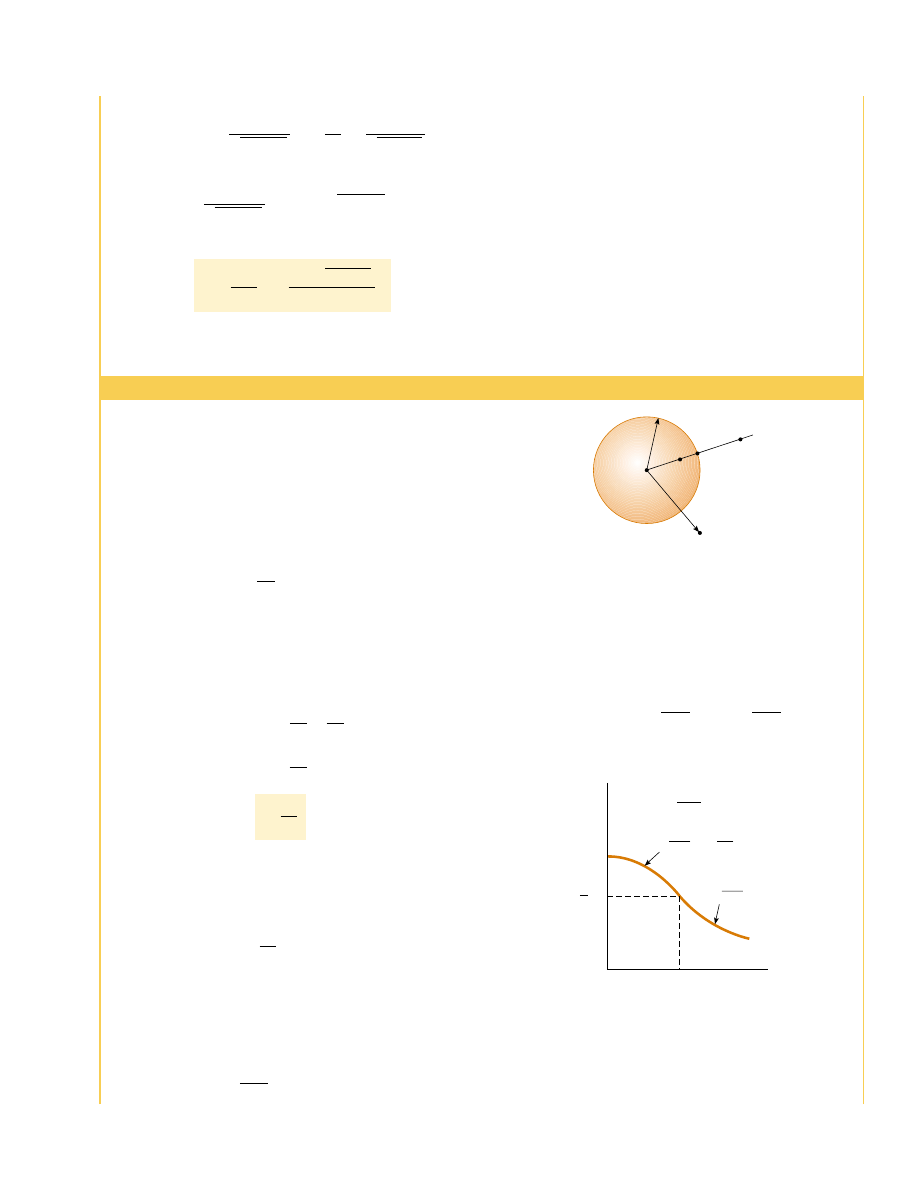Physics For Scientists And Engineers 6E - part 195

SECTION 25.5 • Electric Potential Due to Continuous Charge Distributions
777
Example 25.8 Electric Potential Due to a Uniformly Charged Sphere
We can use this result and Equation 25.3 to evaluate the
potential difference V
D
!
V
C
at some interior point D:
V
D
!
V
C
# !
!
r
R
E
r
dr # !
k
e
Q
R
3
!
r
R
r dr #
k
e
Q
2R
3
(R
2
!
r
2
)
An insulating solid sphere of radius R has a uniform positive
volume charge density and total charge Q.
(A)
Find the electric potential at a point outside the sphere,
that is, for r . R. Take the potential to be zero at r # *.
Solution In Example 24.5, we found that the magnitude of
the electric field outside a uniformly charged sphere of
radius R is
where the field is directed radially outward when Q is posi-
tive. This is the same as the field due to a point charge,
which we studied in Section 23.4. In this case, to obtain the
electric potential at an exterior point, such as B in Figure
25.19, we use Equation 25.10, choosing point A as r # *:
(for r . R)
Because the potential must be continuous at r # R, we
can use this expression to obtain the potential at the surface
of the sphere. That is, the potential at a point such as C
shown in Figure 25.19 is
(B)
Find the potential at a point inside the sphere, that is,
for r & R.
Solution In Example 24.5 we found that the electric field
inside an insulating uniformly charged sphere is
E
r
#
k
e
Q
R
3
r
(for r & R
)
V
C
#
k
e
Q
R
(for r # R)
k
e
Q
r
V
B
#
V
B
!
0 # k
e
Q
$
1
r
B
!
0
%
V
B
!
V
A
#
k
e
Q
$
1
r
B
!
1
r
A
%
E
r
#
k
e
Q
r
2
(for r . R
)
constants, we find that
This integral has the following value (see Appendix B):
Evaluating V, we find
(25.25)
What If?
What if we were asked to find the electric field at
point P? Would this be a simple calculation?
V #
k
e
Q
!
ln
'
! )
√
!
2
)
a
2
a
(
!
dx
√
x
2
)
a
2
#
ln
(x )
√
x
2
)
a
2
)
V # k
e
1
!
!
0
dx
√
x
2
)
a
2
#
k
e
Q
!
!
!
0
dx
√
x
2
)
a
2
Answer Calculating the electric field by means of Equation
23.11 would be a little messy. There is no symmetry to appeal
to, and the integration over the line of charge would repre-
sent a vector addition of electric fields at point P. Using
Equation 25.18, we could find E
y
by replacing a with y in
Equation 25.25 and performing the differentiation with
respect to y. Because the charged rod in Figure 25.18 lies
entirely to the right of x # 0, the electric field at point P
would have an x component to the left if the rod is charged
positively. We cannot use Equation 25.18 to find the x
component of the field, however, because we evaluated the
potential due to the rod at a specific value of x (x # 0) rather
than a general value of x. We would need to find the poten-
tial as a function of both x and y to be able to find the x and
y components of the electric field using Equation 25.25.
V
V
0
V
0
2
3
R
r
V
B
=
k
e
Q
r
V
D
=
k
e
Q
2R
3 –
r
2
R
2
V
0
=
3k
e
Q
2R
(
(
Figure 25.20 (Example 25.8) A plot of electric potential V
versus distance r from the center of a uniformly charged
insulating sphere of radius R. The curve for V
D
inside the
sphere is parabolic and joins smoothly with the curve for V
B
outside the sphere, which is a hyperbola. The potential has a
maximum value V
0
at the center of the sphere. We could make
this graph three dimensional (similar to Figures 25.8 and 25.9)
by revolving it around the vertical axis.
R
r
Q
D
C
B
Figure 25.19 (Example 25.8) A uniformly charged insulating
sphere of radius R and total charge Q. The electric potentials at
points B and C are equivalent to those produced by a point
charge Q located at the center of the sphere, but this is not true
for point D.